Economic Principles: Analyzing Externalities, Investment, and Income
VerifiedAdded on 2020/03/01
|7
|1457
|192
Homework Assignment
AI Summary
This economics assignment delves into several key macroeconomic concepts. It begins by illustrating negative and positive externalities using graphical representations, focusing on the provision of education and the impact of government subsidies. The assignment then explores the Keynesian cross model, explaining how changes in aggregate demand, particularly investment expenditure, affect GDP and unemployment levels. It also analyzes Australia's unemployment rate, discussing the challenges of achieving full employment and the impact of cyclical unemployment. Finally, the assignment applies aggregate expenditure functions to calculate equilibrium income, consumption expenditure, and the multiplier effect, demonstrating the impact of increased government spending on real GDP. The assignment draws on various economic theories and provides practical applications of economic principles.
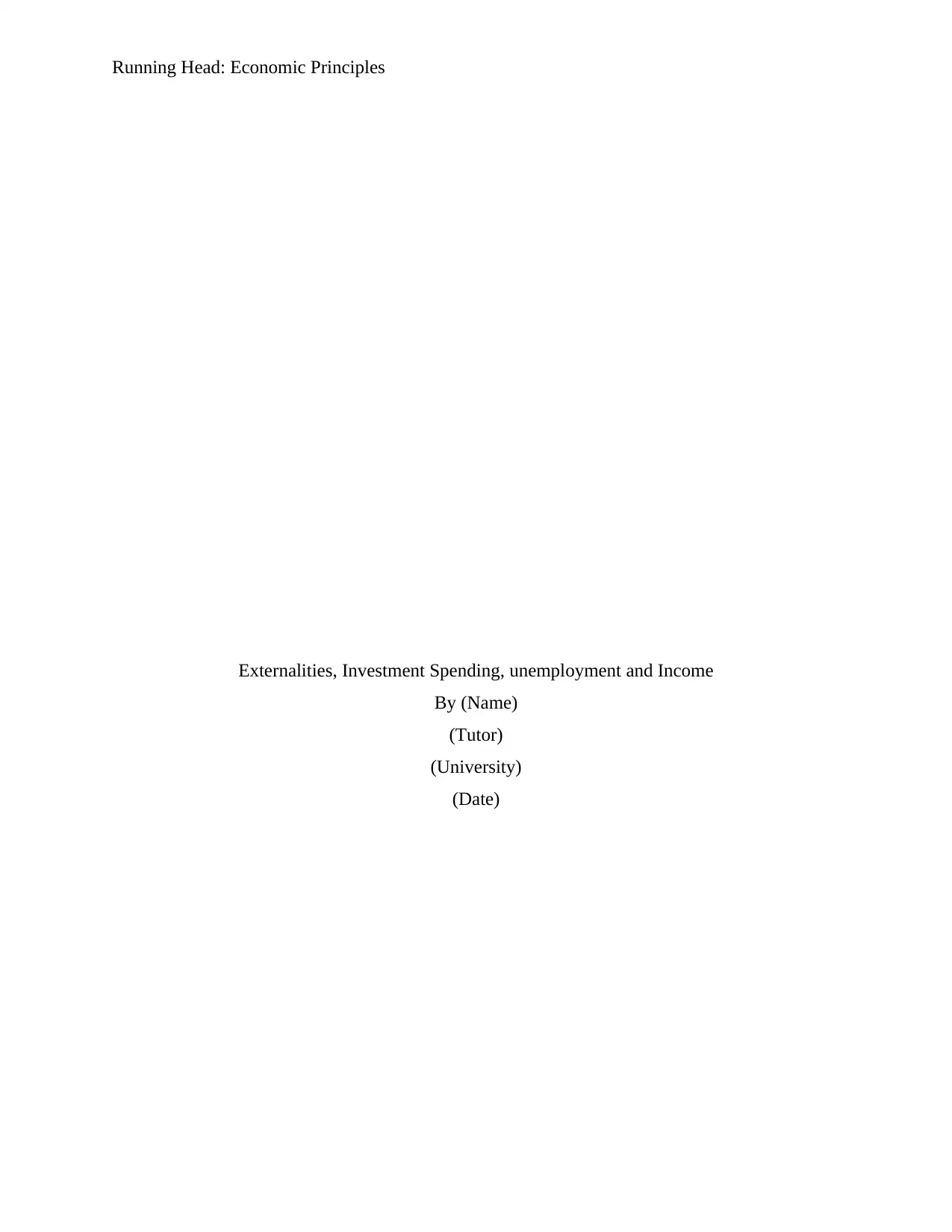
Running Head: Economic Principles
Externalities, Investment Spending, unemployment and Income
By (Name)
(Tutor)
(University)
(Date)
Externalities, Investment Spending, unemployment and Income
By (Name)
(Tutor)
(University)
(Date)
Paraphrase This Document
Need a fresh take? Get an instant paraphrase of this document with our AI Paraphraser
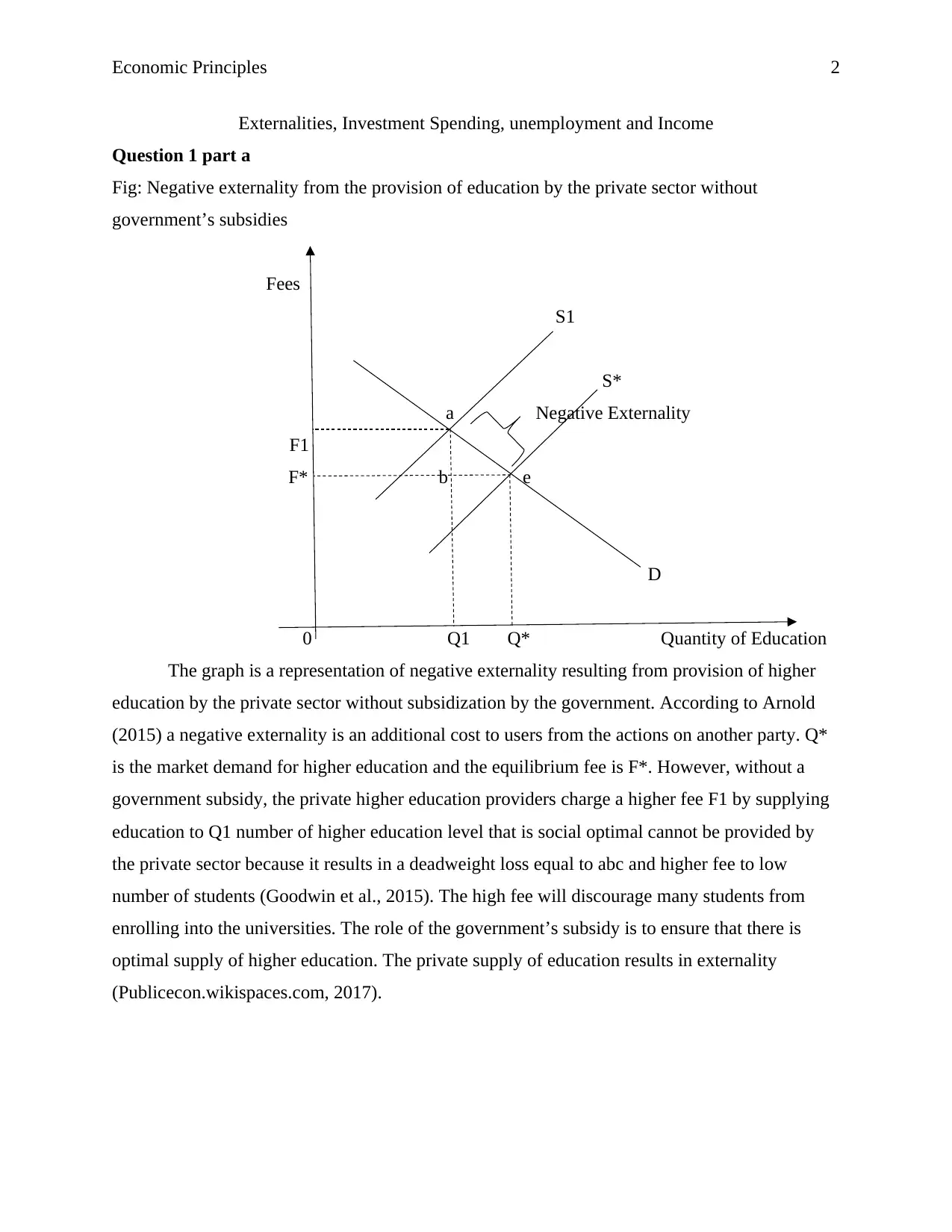
Economic Principles 2
Externalities, Investment Spending, unemployment and Income
Question 1 part a
Fig: Negative externality from the provision of education by the private sector without
government’s subsidies
Fees
S1
S*
a Negative Externality
F1
F* b e
D
0 Q1 Q* Quantity of Education
The graph is a representation of negative externality resulting from provision of higher
education by the private sector without subsidization by the government. According to Arnold
(2015) a negative externality is an additional cost to users from the actions on another party. Q*
is the market demand for higher education and the equilibrium fee is F*. However, without a
government subsidy, the private higher education providers charge a higher fee F1 by supplying
education to Q1 number of higher education level that is social optimal cannot be provided by
the private sector because it results in a deadweight loss equal to abc and higher fee to low
number of students (Goodwin et al., 2015). The high fee will discourage many students from
enrolling into the universities. The role of the government’s subsidy is to ensure that there is
optimal supply of higher education. The private supply of education results in externality
(Publicecon.wikispaces.com, 2017).
Externalities, Investment Spending, unemployment and Income
Question 1 part a
Fig: Negative externality from the provision of education by the private sector without
government’s subsidies
Fees
S1
S*
a Negative Externality
F1
F* b e
D
0 Q1 Q* Quantity of Education
The graph is a representation of negative externality resulting from provision of higher
education by the private sector without subsidization by the government. According to Arnold
(2015) a negative externality is an additional cost to users from the actions on another party. Q*
is the market demand for higher education and the equilibrium fee is F*. However, without a
government subsidy, the private higher education providers charge a higher fee F1 by supplying
education to Q1 number of higher education level that is social optimal cannot be provided by
the private sector because it results in a deadweight loss equal to abc and higher fee to low
number of students (Goodwin et al., 2015). The high fee will discourage many students from
enrolling into the universities. The role of the government’s subsidy is to ensure that there is
optimal supply of higher education. The private supply of education results in externality
(Publicecon.wikispaces.com, 2017).
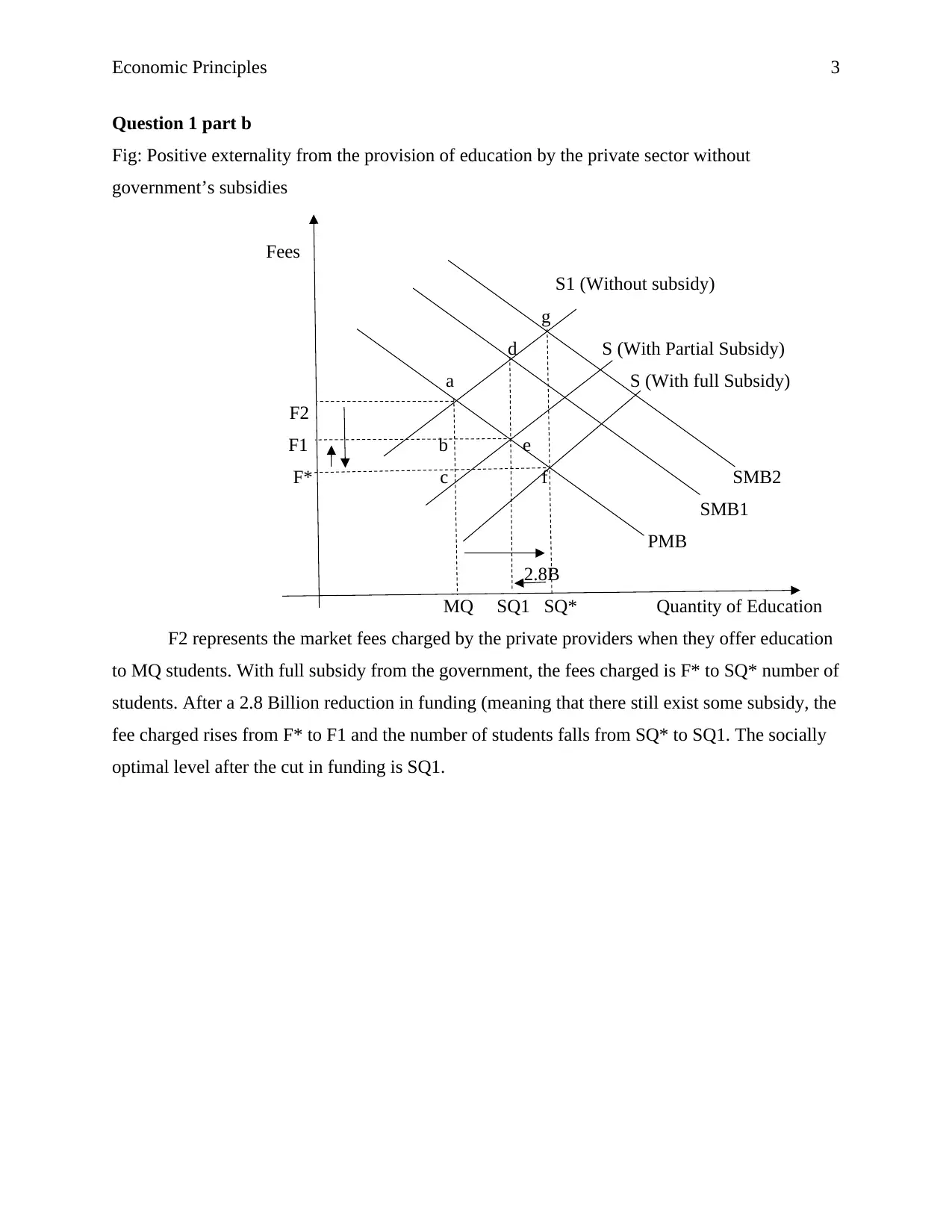
Economic Principles 3
Question 1 part b
Fig: Positive externality from the provision of education by the private sector without
government’s subsidies
Fees
S1 (Without subsidy)
g
d S (With Partial Subsidy)
a S (With full Subsidy)
F2
F1 b e
F* c f SMB2
SMB1
PMB
2.8B
MQ SQ1 SQ* Quantity of Education
F2 represents the market fees charged by the private providers when they offer education
to MQ students. With full subsidy from the government, the fees charged is F* to SQ* number of
students. After a 2.8 Billion reduction in funding (meaning that there still exist some subsidy, the
fee charged rises from F* to F1 and the number of students falls from SQ* to SQ1. The socially
optimal level after the cut in funding is SQ1.
Question 1 part b
Fig: Positive externality from the provision of education by the private sector without
government’s subsidies
Fees
S1 (Without subsidy)
g
d S (With Partial Subsidy)
a S (With full Subsidy)
F2
F1 b e
F* c f SMB2
SMB1
PMB
2.8B
MQ SQ1 SQ* Quantity of Education
F2 represents the market fees charged by the private providers when they offer education
to MQ students. With full subsidy from the government, the fees charged is F* to SQ* number of
students. After a 2.8 Billion reduction in funding (meaning that there still exist some subsidy, the
fee charged rises from F* to F1 and the number of students falls from SQ* to SQ1. The socially
optimal level after the cut in funding is SQ1.
⊘ This is a preview!⊘
Do you want full access?
Subscribe today to unlock all pages.

Trusted by 1+ million students worldwide
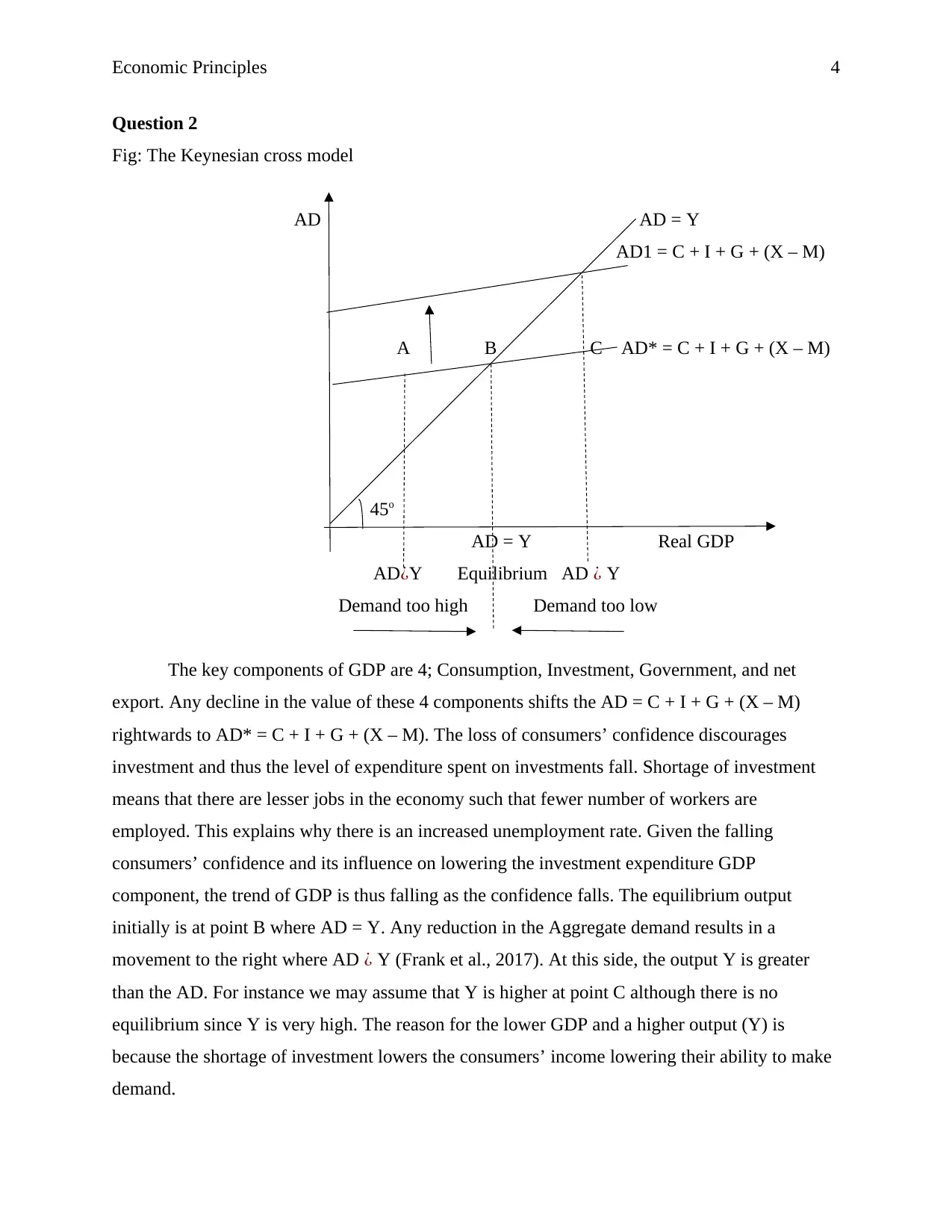
Economic Principles 4
Question 2
Fig: The Keynesian cross model
AD AD = Y
AD1 = C + I + G + (X – M)
A B C AD* = C + I + G + (X – M)
45o
AD = Y Real GDP
AD¿Y Equilibrium AD ¿ Y
Demand too high Demand too low
The key components of GDP are 4; Consumption, Investment, Government, and net
export. Any decline in the value of these 4 components shifts the AD = C + I + G + (X – M)
rightwards to AD* = C + I + G + (X – M). The loss of consumers’ confidence discourages
investment and thus the level of expenditure spent on investments fall. Shortage of investment
means that there are lesser jobs in the economy such that fewer number of workers are
employed. This explains why there is an increased unemployment rate. Given the falling
consumers’ confidence and its influence on lowering the investment expenditure GDP
component, the trend of GDP is thus falling as the confidence falls. The equilibrium output
initially is at point B where AD = Y. Any reduction in the Aggregate demand results in a
movement to the right where AD ¿ Y (Frank et al., 2017). At this side, the output Y is greater
than the AD. For instance we may assume that Y is higher at point C although there is no
equilibrium since Y is very high. The reason for the lower GDP and a higher output (Y) is
because the shortage of investment lowers the consumers’ income lowering their ability to make
demand.
Question 2
Fig: The Keynesian cross model
AD AD = Y
AD1 = C + I + G + (X – M)
A B C AD* = C + I + G + (X – M)
45o
AD = Y Real GDP
AD¿Y Equilibrium AD ¿ Y
Demand too high Demand too low
The key components of GDP are 4; Consumption, Investment, Government, and net
export. Any decline in the value of these 4 components shifts the AD = C + I + G + (X – M)
rightwards to AD* = C + I + G + (X – M). The loss of consumers’ confidence discourages
investment and thus the level of expenditure spent on investments fall. Shortage of investment
means that there are lesser jobs in the economy such that fewer number of workers are
employed. This explains why there is an increased unemployment rate. Given the falling
consumers’ confidence and its influence on lowering the investment expenditure GDP
component, the trend of GDP is thus falling as the confidence falls. The equilibrium output
initially is at point B where AD = Y. Any reduction in the Aggregate demand results in a
movement to the right where AD ¿ Y (Frank et al., 2017). At this side, the output Y is greater
than the AD. For instance we may assume that Y is higher at point C although there is no
equilibrium since Y is very high. The reason for the lower GDP and a higher output (Y) is
because the shortage of investment lowers the consumers’ income lowering their ability to make
demand.
Paraphrase This Document
Need a fresh take? Get an instant paraphrase of this document with our AI Paraphraser
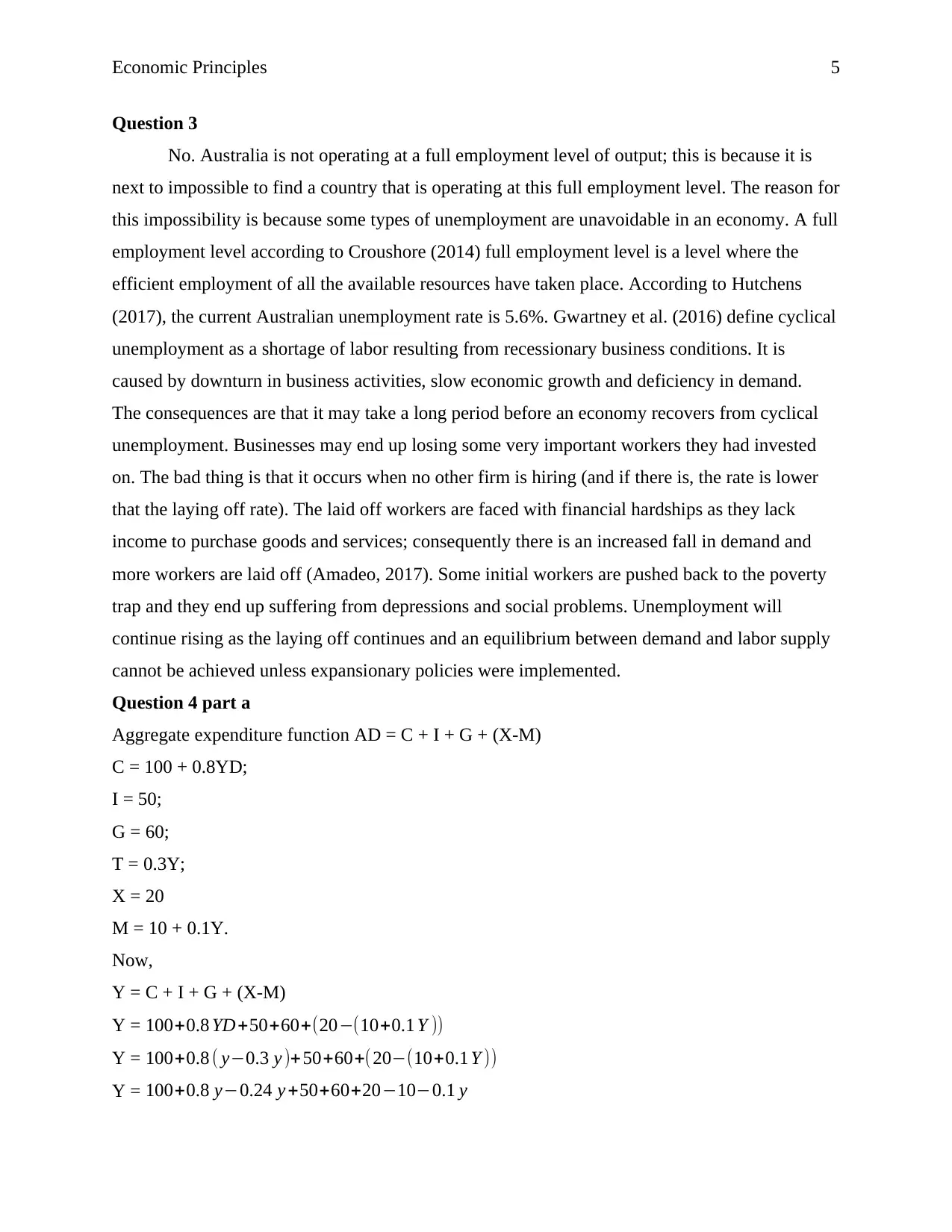
Economic Principles 5
Question 3
No. Australia is not operating at a full employment level of output; this is because it is
next to impossible to find a country that is operating at this full employment level. The reason for
this impossibility is because some types of unemployment are unavoidable in an economy. A full
employment level according to Croushore (2014) full employment level is a level where the
efficient employment of all the available resources have taken place. According to Hutchens
(2017), the current Australian unemployment rate is 5.6%. Gwartney et al. (2016) define cyclical
unemployment as a shortage of labor resulting from recessionary business conditions. It is
caused by downturn in business activities, slow economic growth and deficiency in demand.
The consequences are that it may take a long period before an economy recovers from cyclical
unemployment. Businesses may end up losing some very important workers they had invested
on. The bad thing is that it occurs when no other firm is hiring (and if there is, the rate is lower
that the laying off rate). The laid off workers are faced with financial hardships as they lack
income to purchase goods and services; consequently there is an increased fall in demand and
more workers are laid off (Amadeo, 2017). Some initial workers are pushed back to the poverty
trap and they end up suffering from depressions and social problems. Unemployment will
continue rising as the laying off continues and an equilibrium between demand and labor supply
cannot be achieved unless expansionary policies were implemented.
Question 4 part a
Aggregate expenditure function AD = C + I + G + (X-M)
C = 100 + 0.8YD;
I = 50;
G = 60;
T = 0.3Y;
X = 20
M = 10 + 0.1Y.
Now,
Y = C + I + G + (X-M)
Y = 100+0.8 YD +50+60+(20−(10+0.1 Y ))
Y = 100+0.8 ( y−0.3 y )+ 50+60+(20−(10+0.1 Y ))
Y = 100+0.8 y−0.24 y +50+60+20−10−0.1 y
Question 3
No. Australia is not operating at a full employment level of output; this is because it is
next to impossible to find a country that is operating at this full employment level. The reason for
this impossibility is because some types of unemployment are unavoidable in an economy. A full
employment level according to Croushore (2014) full employment level is a level where the
efficient employment of all the available resources have taken place. According to Hutchens
(2017), the current Australian unemployment rate is 5.6%. Gwartney et al. (2016) define cyclical
unemployment as a shortage of labor resulting from recessionary business conditions. It is
caused by downturn in business activities, slow economic growth and deficiency in demand.
The consequences are that it may take a long period before an economy recovers from cyclical
unemployment. Businesses may end up losing some very important workers they had invested
on. The bad thing is that it occurs when no other firm is hiring (and if there is, the rate is lower
that the laying off rate). The laid off workers are faced with financial hardships as they lack
income to purchase goods and services; consequently there is an increased fall in demand and
more workers are laid off (Amadeo, 2017). Some initial workers are pushed back to the poverty
trap and they end up suffering from depressions and social problems. Unemployment will
continue rising as the laying off continues and an equilibrium between demand and labor supply
cannot be achieved unless expansionary policies were implemented.
Question 4 part a
Aggregate expenditure function AD = C + I + G + (X-M)
C = 100 + 0.8YD;
I = 50;
G = 60;
T = 0.3Y;
X = 20
M = 10 + 0.1Y.
Now,
Y = C + I + G + (X-M)
Y = 100+0.8 YD +50+60+(20−(10+0.1 Y ))
Y = 100+0.8 ( y−0.3 y )+ 50+60+(20−(10+0.1 Y ))
Y = 100+0.8 y−0.24 y +50+60+20−10−0.1 y
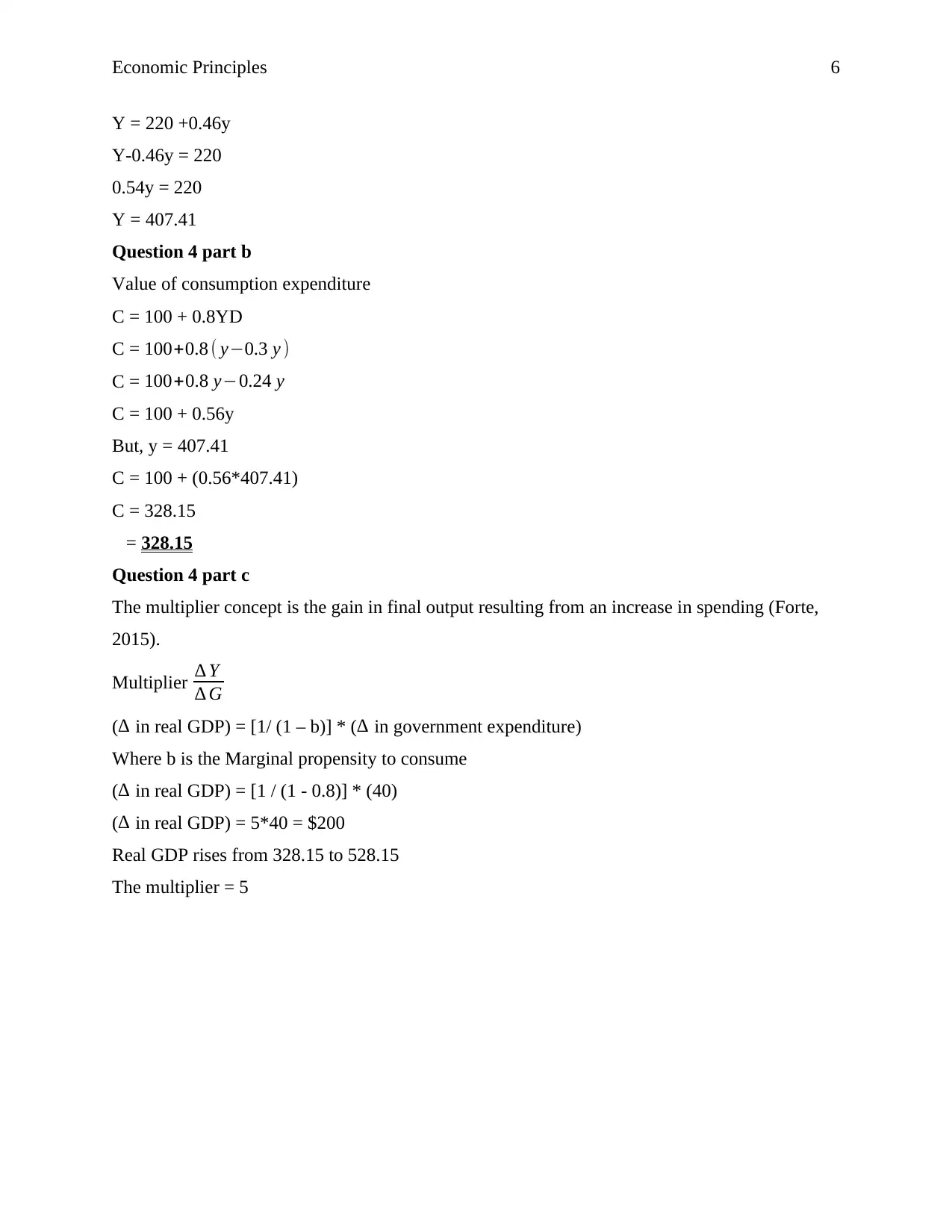
Economic Principles 6
Y = 220 +0.46y
Y-0.46y = 220
0.54y = 220
Y = 407.41
Question 4 part b
Value of consumption expenditure
C = 100 + 0.8YD
C = 100+0.8 ( y−0.3 y )
C = 100+0.8 y−0.24 y
C = 100 + 0.56y
But, y = 407.41
C = 100 + (0.56*407.41)
C = 328.15
= 328.15
Question 4 part c
The multiplier concept is the gain in final output resulting from an increase in spending (Forte,
2015).
Multiplier ∆ Y
∆ G
(∆ in real GDP) = [1/ (1 – b)] * (∆ in government expenditure)
Where b is the Marginal propensity to consume
(∆ in real GDP) = [1 / (1 - 0.8)] * (40)
(∆ in real GDP) = 5*40 = $200
Real GDP rises from 328.15 to 528.15
The multiplier = 5
Y = 220 +0.46y
Y-0.46y = 220
0.54y = 220
Y = 407.41
Question 4 part b
Value of consumption expenditure
C = 100 + 0.8YD
C = 100+0.8 ( y−0.3 y )
C = 100+0.8 y−0.24 y
C = 100 + 0.56y
But, y = 407.41
C = 100 + (0.56*407.41)
C = 328.15
= 328.15
Question 4 part c
The multiplier concept is the gain in final output resulting from an increase in spending (Forte,
2015).
Multiplier ∆ Y
∆ G
(∆ in real GDP) = [1/ (1 – b)] * (∆ in government expenditure)
Where b is the Marginal propensity to consume
(∆ in real GDP) = [1 / (1 - 0.8)] * (40)
(∆ in real GDP) = 5*40 = $200
Real GDP rises from 328.15 to 528.15
The multiplier = 5
⊘ This is a preview!⊘
Do you want full access?
Subscribe today to unlock all pages.

Trusted by 1+ million students worldwide
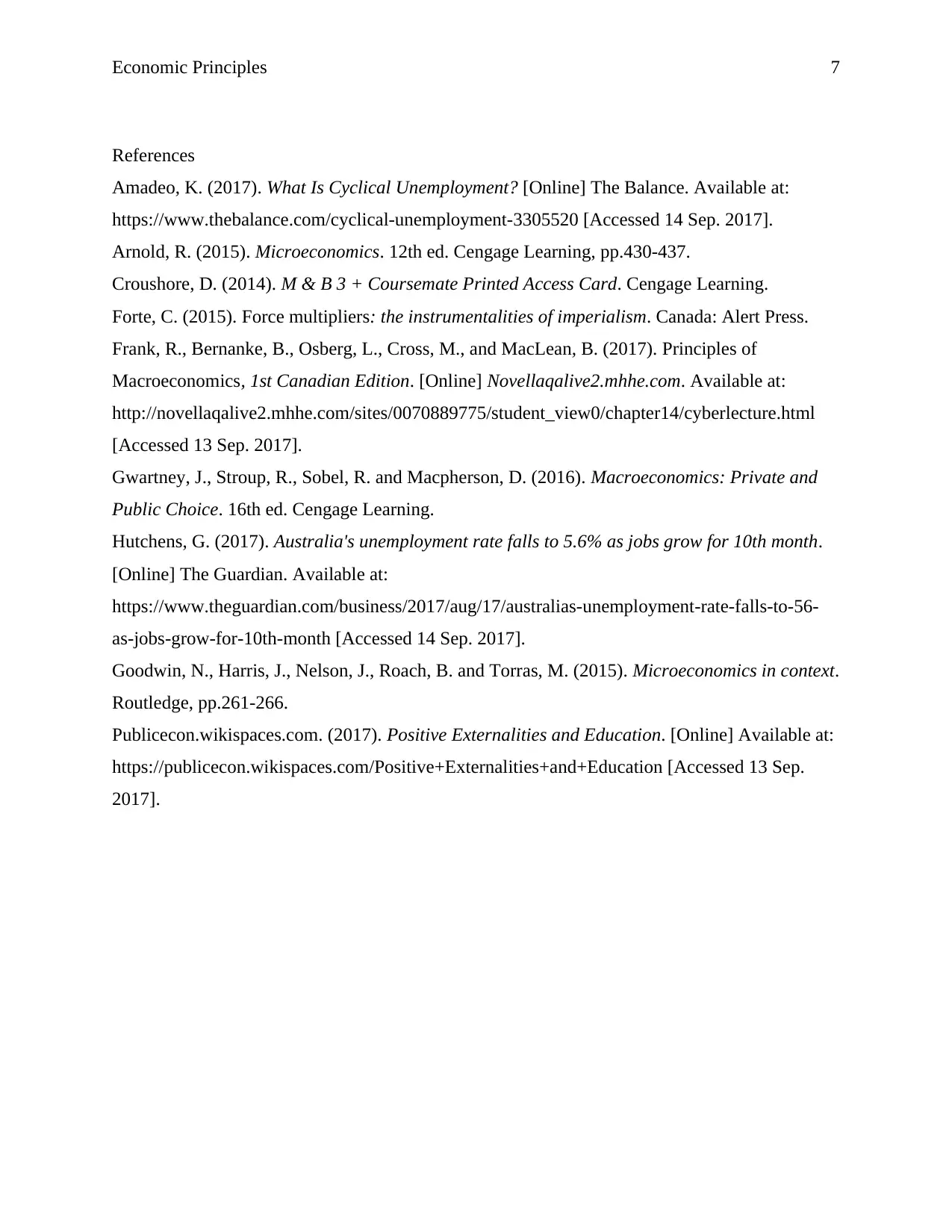
Economic Principles 7
References
Amadeo, K. (2017). What Is Cyclical Unemployment? [Online] The Balance. Available at:
https://www.thebalance.com/cyclical-unemployment-3305520 [Accessed 14 Sep. 2017].
Arnold, R. (2015). Microeconomics. 12th ed. Cengage Learning, pp.430-437.
Croushore, D. (2014). M & B 3 + Coursemate Printed Access Card. Cengage Learning.
Forte, C. (2015). Force multipliers: the instrumentalities of imperialism. Canada: Alert Press.
Frank, R., Bernanke, B., Osberg, L., Cross, M., and MacLean, B. (2017). Principles of
Macroeconomics, 1st Canadian Edition. [Online] Novellaqalive2.mhhe.com. Available at:
http://novellaqalive2.mhhe.com/sites/0070889775/student_view0/chapter14/cyberlecture.html
[Accessed 13 Sep. 2017].
Gwartney, J., Stroup, R., Sobel, R. and Macpherson, D. (2016). Macroeconomics: Private and
Public Choice. 16th ed. Cengage Learning.
Hutchens, G. (2017). Australia's unemployment rate falls to 5.6% as jobs grow for 10th month.
[Online] The Guardian. Available at:
https://www.theguardian.com/business/2017/aug/17/australias-unemployment-rate-falls-to-56-
as-jobs-grow-for-10th-month [Accessed 14 Sep. 2017].
Goodwin, N., Harris, J., Nelson, J., Roach, B. and Torras, M. (2015). Microeconomics in context.
Routledge, pp.261-266.
Publicecon.wikispaces.com. (2017). Positive Externalities and Education. [Online] Available at:
https://publicecon.wikispaces.com/Positive+Externalities+and+Education [Accessed 13 Sep.
2017].
References
Amadeo, K. (2017). What Is Cyclical Unemployment? [Online] The Balance. Available at:
https://www.thebalance.com/cyclical-unemployment-3305520 [Accessed 14 Sep. 2017].
Arnold, R. (2015). Microeconomics. 12th ed. Cengage Learning, pp.430-437.
Croushore, D. (2014). M & B 3 + Coursemate Printed Access Card. Cengage Learning.
Forte, C. (2015). Force multipliers: the instrumentalities of imperialism. Canada: Alert Press.
Frank, R., Bernanke, B., Osberg, L., Cross, M., and MacLean, B. (2017). Principles of
Macroeconomics, 1st Canadian Edition. [Online] Novellaqalive2.mhhe.com. Available at:
http://novellaqalive2.mhhe.com/sites/0070889775/student_view0/chapter14/cyberlecture.html
[Accessed 13 Sep. 2017].
Gwartney, J., Stroup, R., Sobel, R. and Macpherson, D. (2016). Macroeconomics: Private and
Public Choice. 16th ed. Cengage Learning.
Hutchens, G. (2017). Australia's unemployment rate falls to 5.6% as jobs grow for 10th month.
[Online] The Guardian. Available at:
https://www.theguardian.com/business/2017/aug/17/australias-unemployment-rate-falls-to-56-
as-jobs-grow-for-10th-month [Accessed 14 Sep. 2017].
Goodwin, N., Harris, J., Nelson, J., Roach, B. and Torras, M. (2015). Microeconomics in context.
Routledge, pp.261-266.
Publicecon.wikispaces.com. (2017). Positive Externalities and Education. [Online] Available at:
https://publicecon.wikispaces.com/Positive+Externalities+and+Education [Accessed 13 Sep.
2017].
1 out of 7
Your All-in-One AI-Powered Toolkit for Academic Success.
+13062052269
info@desklib.com
Available 24*7 on WhatsApp / Email
![[object Object]](/_next/static/media/star-bottom.7253800d.svg)
Unlock your academic potential
Copyright © 2020–2025 A2Z Services. All Rights Reserved. Developed and managed by ZUCOL.